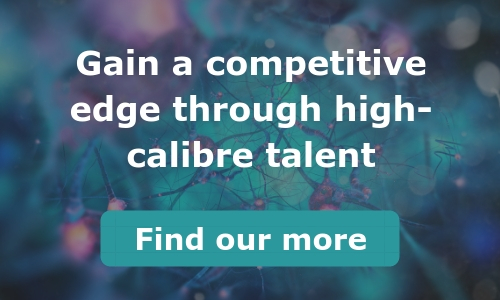Is your company considered a great place to work? Does it draw top talent like your corporate brand attracts patients or customers? If not, why not?
In a candidate-led market with fierce competition for talent, both within the life sciences and related industries, employer brand can’t go ignored. According to LinkedIn, a strong employer brand can lead to 50% more qualified applicants while reducing cost-per-hire by up to 50%. Even if the tables were turned and fewer life science organisations looked to increase headcount, the business case would still stand firm. Why? Facing economic uncertainty and deficit of skilled workers, most life science CEO’s would advocate upskilling their existing workforce. However, if this re-skilled workforce then ups and leaves, it represents a tremendous loss to the business. Employer brand can reduce employer turnover by up to 28%.
Like what you’re reading? Then check out our other articles on employer brand:
- What is Employer Brand and why is it important to your life science recruitment strategy
- Key Employer Brand Challenges in Senior Life Science Recruitment.
- How to Measure the Effectiveness of your Employer Brand.
- 3 Steps to a Powerful Employer Brand that Attracts Top Talent.
In this, our final article, we explore five tips to help you project your employer brand to attract top talent.
1) Know your audience
To project your employer brand effectively, you must first define who it is your are targeting; aligning your message with your intended audience. This starts with candidate segmentation – differentiating between candidates based on seniority (entry level, management, executive), job title (e.g. Head of Manufacturing, Head of Quality), location, language and other criteria that will help you hone in on the type of individual you want to attract. Your segments can be brought to life by developing candidate personas – a semi-fictional representation of the type of candidate you hope to attract. Through using a mixture of quantitative and qualitative data, personas allow you to paint a picture of the candidates needs, wants and preferences.
Candidate segmentation and personas help you to more effectively target candidates by:
- Defining the channels you will use to reach candidates.
- Tailoring the messaging used to engage candidates.
- Deciding upon how to follow up with candidates.
Map out the candidate journey – the stages job seekers go through when researching, applying and accepting a job, paying attention to messaging, tone-of-voice, sentiment and consistency across key touchpoints – career site, company LinkedIn page, job descriptions, jobs ads, social media etc. Is the candidate journey conducive to the type of candidate you hope to attract?
2) Be authentic
If your employees aren’t on side, any efforts to artificially propagate employer brand will be negated by bad reviews on sites like Glassdoor, or worse, negative press. To ensure your employees live and breath your employer brand, you have to ensure that everyone is on the same wavelength and working to the core values you seek to promote. Buy-in across your organisation is essential.
Launch your employee brand internally first. Run workshops across your organisation to communicate your vision and what changes will be made to allow that vision to prosper. To further promote your employer brand, consider creating a steering committee of employer brand champions that are dedicated to continually improving the employer brand.
Brought in employees are your greatest ambassadors. By continually refining your Employer Value Proposition (EVP) and involving your employees in the process, you build a better workplace; the very foundations of a robust employer brand. Employees want to work for companies with a vibrant culture they can be part of and your company culture should match the type of employee you want to attract. By shaping your EVP to match your employees, you create yet another compelling reason why they should stick with you, which in turn strengthens your employer brand.
Finally, remember that actions speak louder than words. Recognise your employees efforts and reward them for doing a good job. If your employer brand is truly authentic, you won’t be short of ways to promote it. Brought in employees will be willing to participate in your employer brand campaigns and endorse your activities by sharing content and social media posts with their network.
3) Tell a story
Everybody wants to know the story behind the business, so take every opportunity to tell your story, ideally through the voice of your employees. Start off by surveying your employees to find out why they joined, what they like, and where there is room for improvement. Not only will this help your sanity check that your employer brand is authentic, but it will help you craft your messaging.
Next, identify employees that are clearly championing your employee brand and conduct more in-depth interviews to find out how the opportunities afforded by working for your organisation have changed their lives. Translate these into snippets, testimonials, or day-in-the-life case studies and videos and publish these across your employer brand touchpoints. Relatable stories on the theme of workplace success/triumph will make your organisation more appealing to employees, both current and future, while providing a peek into your culture and day-to-day activities.
Finally, ensure you are not just broadcasting your story, but encouraging two-way interaction. People want to be part of the conversation. Unless your corporate brand is renowned for doing things differently, avoid controversy. Ask questions and encourage friendly debate across blogs and social media. Be prepared to listen, respond to and action feedback to improve your employer brand.
RELATED: Increase quality-of-hire by partnering with a reputable boutique talent consultancy
4) Breath life into it
When it comes to promoting your employer brand, there are a myriad of channels available. Which ones work for you will depend upon your candidate personas (you want to advertise and promote your employer brand on channels your candidate personas frequent) and resources (time, money). Whichever channels you choose, remember that cadence and consistency are key.
Start with your employees; your greatest employer brand advocates. We’ve already discussed how you can involve your employees, from living and owning the employer brand to actively participating in employer brand content, collateral and campaigns. However, there is a another way employees can boost your employer brand with clear ROI – employee referrals.
There is no better indicator of employee brand buy-in than employee referrals. Not only are employee referrals the leading source of quality, cost-effective hires, but it means your employees are happy to recommend your company to their friends, family and wider network. After all, 92% of people trust recommendations from friends and family more than any other type of advertising.
Likewise, put aside budget for content creation – blogs, brochures, infographics and video. This will appeal to your candidate personas while painting your employer brand in a positive light, helping people understand and visualise your workplace culture. What’s more, fresh, engaging content draws people back to your careers or social media channels time and time again.
While there are a number of different marketing channels and strategies that can give your employer brand traction, never underestimate the power of the spoken work. Get people talking – encourage your current employees to leave reviews. This will be especially beneficial on recruitment websites as it will be directly speaking to those who are considering applying. Also make use of your social media accounts and open up conversations with those within your circle. You can use this as a promotion and also to answer any questions candidates may have.
Now you know what’s working, rectified what isn’t and rallied your employees behind your cause, it’s time to consider more advanced strategies to promote your employer brand. As touched upon earlier, this could be as simple as crafting employer brand-focused content – day-in-the-life videos, employee-focused blogs and testimonials – and encouraging your employees to share them with their wider network. Or it could extend to paid advertising campaigns, employer brand-focused events and much more. The sky’s the limit, but whatever you do, keep it authentic.
5) Create employer brand guidelines [OPTIONAL]
Just like your corporate brand has brand guidance (a.k.a. a “brand book”, “brand standards” or “brand style guide”) outlining what your brand represents and how it should be communicated to your audience, your employer brand should have one too. That way, all parties will have the information they need to ensure your employer brand is consistently implemented.
Employer brand guidelines should incorporate the following 5 sections:
- Employer promise: Your pledge to employees, both prospective and current, as to why they should work for you. Incorporating your Employee Value Proposition (EVP), this statement should reinforce what you stand for (vision, values), what you offer (personal development, working environment), why your employees matter and what you expect from them in return.
- Vision and values: Your vision sets out what your company aspires to be through delivering it’s mission, while your values clarify the fundamental beliefs and guiding principles that your business adheres to in delivering its mission. Together, they provide a roadmap for the attitudes and behaviour that bring about organisational success which is reinforced through your…
- Messaging: Your messaging incorporates tone-of-voice – how your business is represented in words, both written and spoken – and stories – tangible examples of your employer promise in action and the vehicle by which you engage employees, both prospective and current. Select the most appropriate stories to demonstrate key messaging based on audience and scenario.
- Aesthetics: Your visual brand identity should build off of your corporate brand identity. It should contain guidance on your logo (use and positioning), design elements (use of graphical elements other than your logo, for example, white space), colour pallet and fonts (vetted tones and typefaces), and imagery/video (recommended styles, formats, minimum quality etc).
- Go-to-market: Your go-to channels and tried-and-tested templates and step-by-step guidance to quickly and effortlessly role out an employer brand campaign, both in-house or with external assistance (e.g. branding or marketing agency). Also serves as a repository of employer brand assets which can be reused or guide the design of new collateral (adverts, brochures).
For more hiring advice tailored to hiring managers in the life science industry…
- Read 3 Steps To A Powerful Employer Brand That Attracts Top Talent.
- View our talent solutions to see how we can help you gain a competitive edge through talent.
* Fraser Dove International is a talent consultancy operating exclusively across the life sciences industry. While our roots lie in executive search, we provide more than the traditional recruitment services. Uniquely placed within the market, we have been providing cutting-edge talent solutions and insight to organisations at all stages of their journey – from start-up to established leaders – since 2013.

 Estimated read time: 6 mins
Estimated read time: 6 mins Date posted:21/10/2019
Date posted:21/10/2019





